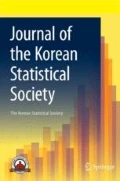Abstract
In order to analyze longitudinal ordinal data, researchers commonly use the cumulative logit random effects model. In these models, the random effects covariance matrix is used to account for both subject variation and serial correlation of repeated outcomes. However, the covariance matrix is assumed to be homoscedastic and restricted due to the high-dimensionality and positive-definiteness of the matrix. In order to relieve these assumptions, three Cholesky decomposition methods were proposed to model the random effects covariance matrix: modified Cholesky, moving average Cholesky, and autoregressive moving-average decompositions. We also use the three decompositions to model the random effects covariance matrix in cumulative logit random effects models for longitudinal ordinal data. In addition, Bayesian methods are presented for the parameter estimation of the proposed models, and Markov Chain Monte Carlo is conducted using the JAGS program. The proposed methods are illustrated using lung cancer data.


Similar content being viewed by others
References
Agresti, A. (2002). Categorial data analysis (2nd ed.). New York: Wiley.
Breslow, N. E., & Clayton, D. G. (1993). Approximate inference in generalized linear mixed models. Journal of the American Statistical Association, 88, 125–134.
Brooks, S. P., & Gelman, A. (1998). Alternative methods for monitoring convergence of iterative simulations. Journal of Computational and Graphical Statistics, 7, 454–455.
Celeux, G., Forbes, F., Robert, C., & Titterington, D. (2006). Deviance information criteria for missing data models. Bayesian Analysis, 1, 651–674.
Daniels, M. J., & Hogan, J. W. (2008). Missing data in longitudinal studies: Strategies for Bayesian modeling and sensitivity analysis. Boca Raton: Chapman & Hall/CRC.
Daniels, M. J., & Zhao, Y. D. (2003). Modeling the random effects covariance matrix in longitudinal data. Statistics in Medicine, 22, 1631–1647.
Diggle, P. J., Heagerty, P., Liang, K. Y., & Zeger, S. L. (2002). Analysis of longitudinal data (2nd ed.). Oxford: Oxford University Press.
Gamerman, D. (1997). Markov chain Monte Carlo: Stochastic simulation for Bayesian inference. Boca Raton: Chapman & Hall/CRC.
Gelman, A., & Rubin, D. (1992). Inference from iterative simulation using multiple sequences. Statistical Science, 7, 457–511.
Han, E.-J., & Lee, K. (2016). Dynamic linear mixed models with ARMA covariance matrix. Communications for Statistical Applications and Methods, 23, 575–585.
Hastings, W. K. (1970). Monte Carlo sampling methods using Markov chains and their applications. Biometrika, 57, 97–109.
Judge, G. G., Griffiths, W. E., Hill, R. C., & Lee, T. C. (1980). The theory and practice of ecomometrics. New York: Wiley.
Kim, J., Sohn, I., & Lee, K. (2017). Bayesian modeling of random effects precision/covariance matrix in cumulative logit random effects models. Communications for Statistical Applications and Methods, 24, 81–96.
Kim, S. T., Uhm, J. E., Lee, J., Sun, J., Sohn, I., Kim, S. W., et al. (2012). Randomized phase study of gefitinib versus erlotinib in patients with advanced non-small cell lung cancer who failed previous chemotherapy. Lung Cancer, 75, 82–88.
Lee, K., Baek, C., & Daniels, M. J. (2017). ARMA Cholesky factor models for the covariance matrix of linear models. Computational Statistics & Data Analysis, 115, 267–280.
Lee, K., & Daniels, M. (2008). Marginalized models for longitudinal ordinal data with application to quality of life studies. Statistics in Medicine, 27, 4359–4380.
Lee, K., Jung, H., & Yoo, J. K. (2019). Modeling of the ARMA random effects covariance matrix in logistic random effects models. Statistical Methods & Applications, 28, 281–299.
Lee, K., & Sung, S. (2014). Autoregressive Cholesky factor model for marginalized random effects model. Communications for Statistical Applications and Methods, 21, 169–181.
Lee, K., & Yoo, J. K. (2014). Bayesian Cholesky factor models in random effects covariance matrix for generalized linear mixed models. Computational Statistics & Data Analysis, 80, 111–116.
Lee, K., Yoo, J. K., Lee, J., & Hagan, J. (2012). Modeling the random effects covariance matrix for the generalized linear mixed models. Computational Statistics & Data Analysis, 56, 1545–1551.
Litiere, S., Alonso, A., & Molenberghs, G. (2007). Type I and type II error under random-effects misspecification in generalized linear mixed models. Biometrics, 63(4), 1038–1044.
Litiere, S., Alonso, A., & Molenberghs, G. (2008). The impact of a misspecified random-effects distribution on the estimation and the performance of inferential procedures in generalized linear mixed models. Statistics in medicine, 27(16), 3125–3144.
Liu, I., & Agresti, A. (2005). The analysis of ordered categorical data: An overview and a survey of recent developments. Test, 14, 1–73.
Pourahmadi, M. (1999). Joint mean-covariance models with applications to longitudinal data: Unconstrained parameterisation. Biometrika, 86, 677–690.
Pourahmadi, M. (2000). Maximum likelihood estimation of generalized linear models for multivariate normal covariance matrix. Biometrika, 87, 425–435.
Rothman, A. J., Levina, E., & Zhu, J. (2010). A new approach to Cholesky-based covariance regularizetion in high dimensions. Biometrika, 97, 539–550.
Spiegelhalter, D., Best, N., Carlin, B., & Germany, B. (2014). The deviance information criterion: 12 years on. Journal of the Royal Statistical Society, Series B, 76, 485–493.
Spiegelhalter, D., Best, N., Carlin, B., & van der Linde, A. (2002). Bayesian measures of model complexity and fit. Journal of the Royal Statistical Society, Series B, 64, 583–640.
Trevisani, M., & Gelfand, A. E. (2003). Inequalities between expected marginal log-likelihoods, with implications for likelihood-based model complexity and comparison measures. Canadian Journal of Statistics, 31, 239–250.
Xue, J., Luo, Y., & Liang, F. (2017). Average (E)BIC-like criteria for Bayesian model selection. Working paper.
Zhang, W., & Leng, C. (2012). A moving average Cholesky factor model in covariance modelling for longitudinal data. Biometrika, 99, 141–150.
Acknowledgements
This work was supported by Basic Science Research Program through the National Research Foundation of Korea (KRF) funded by the Ministry of Education, Science and Technology (NRF-2016R1D1A1B03930343).
Author information
Authors and Affiliations
Corresponding author
Additional information
Publisher's Note
Springer Nature remains neutral with regard to jurisdictional claims in published maps and institutional affiliations.
This paper is based on part of Jiyeong Kim’s PhD thesis.
Rights and permissions
About this article
Cite this article
Kim, J., Sohn, I. & Lee, K. Bayesian cumulative logit random effects models with ARMA random effects covariance matrix. J. Korean Stat. Soc. 49, 32–54 (2020). https://doi.org/10.1007/s42952-019-00003-1
Received:
Accepted:
Published:
Issue Date:
DOI: https://doi.org/10.1007/s42952-019-00003-1




